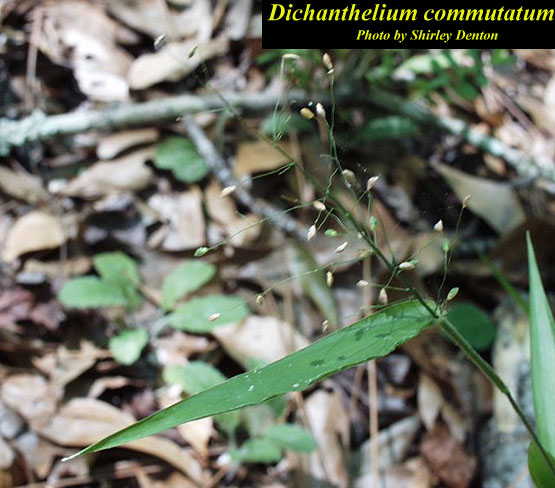Dichanthelium commutatum
Common Names: Variable Panicgrass [1], Variable Witchgrass [2]
| Dichanthelium commutatum | |
|---|---|

| |
| Photo by the Atlas of Florida Plants Database | |
| Scientific classification | |
| Kingdom: | Plantae |
| Division: | Magnoliophyta - Flowering plants |
| Class: | Liliopsida - Moncots |
| Order: | Cyperales |
| Family: | Poaceae |
| Genus: | Dichanthelium |
| Species: | D. communtatum |
| Binomial name | |
| Dichanthelium commutatum Schult. | |

| |
| Natural range of Dichanthelium commutatum from USDA NRCS Plants Database. | |
Contents
[hide]Taxonomic Notes
Synonyms: Panicum commutatum J. A. Schultes; P. commutatum J.A. Schultes var. ashei (Pearson ex Ashe) Fernald; Dichanthelium commutatum (J.A. Shultes) Gould ssp. ashei (Pearson ex Ashe) Freckman & Lelong; Panicum ashei Pearson ex Ashe; Panicum commutatum J. A. Schultes var. commutatum; P. mutabile Scribner & Smith ex Nash; D. commutatum (J.A. Shultes) Gould ssp. commutatum Freckmann & Lelong; D. commutatum (J.A. Shultes) Gould ssp. equilaterale (Scribner) Freckmann & Lelong; D. commutatum (J.A. Shultes) Gould ssp. joori (Vasey) Freckmann & Lelong; Panicum joorii Vasey; P. equilaterale Scribner
Varieties: Dichanthelium commutatum (J.A. Shultes) Gould var. ashei (Pearson ex Ashe) Mohlenbrock; D. commutatum (J.A. Schultes) Gould var. commutatum
Description
D. communtatum is a perennial gramioid of the Poaceae family that is native to North America. [1]
Distribution
D. commutatum is found throughout the eastern United States, reaching as far west as Texas and as far north as Maine and Michigan. [1]
Ecology
Habitat
Common habitats for D. commutatum include low, shaded, moist woodlands and edges of woodlands, as well as dry, thin, and rocky woods and thickets. [3]
D. commutatum has a medium tolerance for drought and shade. [1]
Specimens of panicgrass have been collected in habitats that include drying loamy sand, near limestone wooded area, hardwood hammocks, longleaf pine woodland, dry sandy soil, flat oak woods, margin of field, dry banks, slash pine savanna, edge of wooded floodplain, swamp clearing, oak hammock, oak woodland, mixed hardwood forests, shaded hardwood, and swamp forests. [4]
This species does not require a moist environment but it can grow in wetter condition. [1]
Phenology
D. commutatum has been observed flowering in the spring, with peak inflorescence in April. [5]
Seed dispersal
This species is thought to be dispersed by gravity. [6]
Fire ecology
D. commutatum has no tolerance for fire. [1]
Use by animals
This grass can be a supplementary food source for many terrestrial birds. [1]
Conservation and Management
D. commutatum is considered endangered in the state of Illinois. [1]
Cultivation and restoration
Photo Gallery
References and notes
- ↑ Jump up to: 1.0 1.1 1.2 1.3 1.4 1.5 1.6 1.7 USDA Plant Database
- Jump up ↑ Glitzenstein, J. S., et al. (2012). "Fire-frequency effects on vegetation in north Florida pinelands: Another look at the long-term Stoddard Fire Research Plots at Tall Timbers Research Station." Forest Ecology and Management 264: 197-209.
- Jump up ↑ Weakley, A. S. (2015). Flora of the Southern and Mid-Atlantic States. Chapel Hill, NC, University of North Carolina Herbarium.
- Jump up ↑ URL: http://herbarium.bio.fsu.edu. Last accessed: June 2018. Collectors: Loran C. Anderson, Wilson Baker, Cecil R. Slaughter, H. Blomquist, Robert A. Norris, James P. Gillespie, H. R. Reed, R. Kral, R. Wilbur, Harry Ahles, A. Hammond, Delzie Demaree, H. Sherman, G. Carter, John W. Thierst, S. Blake, Frank Bowers, Gary Morton, Paul Hallister, Ken Rogers, r. K. Godfrey, Stanley Cain, Duane Isely, S Walsh, Dwight Isely, Sidneu McDaniel, C. Clark, W. Silveus, W. Ashe, S. Leonard, A. Radford, Randy Haynes, C. Jackson, R. L. Lazor, A. . Clewell, James . Ray Jr.., H. Kurz, Ira Wiggins, D. B. Ward, D. Burch, George Cooley, Gwynn Ramsey, R. S. Mitchell, Richard Eaton, Patricia Elliot, D.L. Martin, S. Cooper, D. Hall, Bob Simmons, Buford Pruitt, R.L. Wilbur, G. Webster, A. Curtiss, R.E. Perdue, Sid McDaniel, Bruce Hansen, JoAnn Hansen, A. G. Shuey, Gil Nelson, Marc Mino, J. M. Kane, Lisa Keppner, L. Peed, F. Sargent, R.E. Perdue, J.B. McFarlin, O. Lakela. States and counties: Florida ( Taylor, Jefferson, Jackson, Indian River, Wakulla, Thomas, Gadsden, Leon, Franklin, Walton, Madison, Volusia, Calhoun, Okaloosa, Clay, Levy, Lafayette, Escambia, Monroe, Flagler, Hernando, Suwannee, Citrus, Liberty, Bay, Marion, Nassau, Highlands, Duval, Alachua, St. John, DeSoto, Polk, Brevard, Washington, Dixie, Holmes), North Carolina (Brunswick, granville, Cumberland, Dare), Georgia (Lee, Thomas, Grady), Alabama (Geneva), Mississippi (Hancock), Louisiana (DCaldwell, Ouachita, Umiom, St. Landry, St. Mary), Virginia (Montgomery, Dickenson, Arlington, Roanoke), Arkansas (Cleburne, Stone), Alabama (De Kalb, Houston), Massachusetts, Tennessee (Bradley, Putnam, Franklin), Kentucky (Carlisle), Texas (Burleson), South Carolina (Chester), Missouir (McDonald)
- Jump up ↑ Nelson, G. PanFlora: Plant data for the eastern United States with emphasis on the Southeastern Coastal Plains, Florida, and the Florida Panhandle. www.gilnelson.com/PanFlora/ Accessed: 21 MAY 2018
- Jump up ↑ Kirkman, L. Katherine. Unpublished database of seed dispersal mode of plants found in Coastal Plain longleaf pine-grasslands of the Jones Ecological Research Center, Georgia.